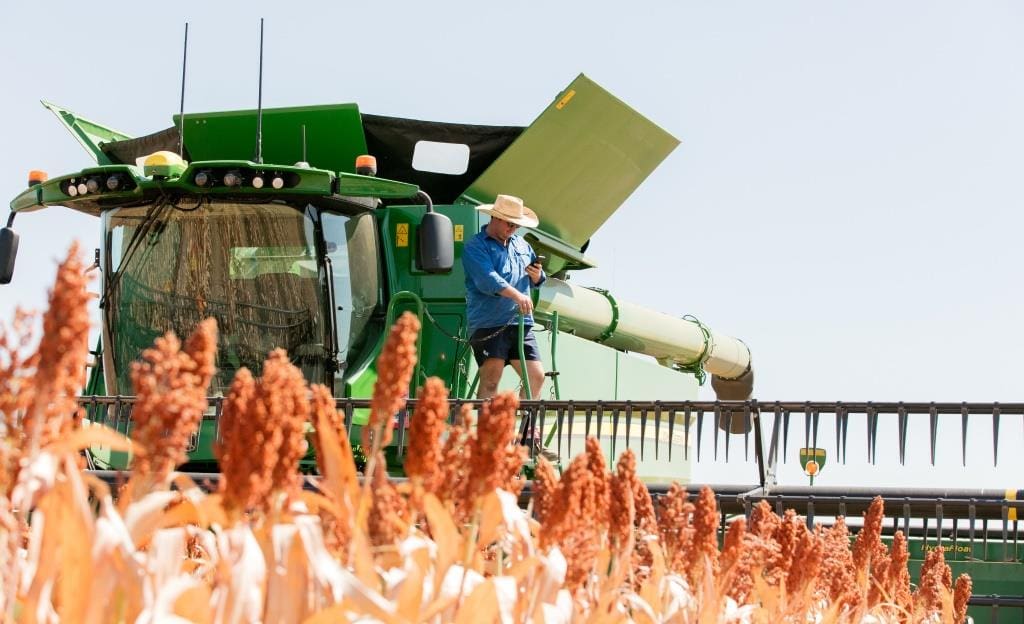
Doolin Agriculture farm manager Henry Dight takes a break from sorghum harvesting at North Star. Photo: John Deere
PRICES for wheat have firmed in the past week in response to thin selling from growers and the re-emergence of some modest export demand, while barley has traded sideways to lower on lacklustre interest.
The sorghum harvest is gathering pace in northern New South Wales and southern Queensland, but early volume is limited so prices have crept up a dollar or two.
Growers across south-eastern Australia are making a start on early-season planting of grazing oats, and of dual-purpose canola ahead of the main winter-crop seeding window opening next month.
| Today | Mar 7 | |
| Barley Downs | $360 | $365 |
| ASW wheat Downs | $360 | $355 |
| Sorghum Downs | $352 | $350 |
| Barley Melbourne | $310 | $310 |
| ASW wheat Melbourne | $330 | $320 |
Table 1: Indicative prices in Australian dollars per tonne.
North
Domestic consumers remain well covered on wheat as they switch from summer to winter rations, and away from barley for the cooler months.
“You’re working hard to get people to put up their hands,” one trader said.
On sorghum, feeding demand is confined to the poultry and pig sectors, with both seen as having enough coverage to get them into April-May, when harvest volume is expected to peak.
“Sorghum delivered Downs is back to $342-$345/t for April-May.
“They’re paying a premium at the moment to get into containers.”
Bulk shipments of sorghum are yet to appear on stems, but are expected to pop up for Qld ports, and possibly Newcastle in NSW too, once tonnage starts to accumulate at depots.
“Considering what’s on our doorstep, there’s not a lot sold.”
Cash bids at receival sites on the Downs are sitting at around $320/t, well below what some container packers are willing to pay.
Early indications are for good yields in southern Qld and northern NSW, with 6-8t/ha, and more in places, shaping up for dryland crops that got the best of the summer rain.
In a bid to draw white grain into the system over harvest, some bulk handlers have offered from storage to March 31 or June 30.
“Once it’s in the system, it’s very hard for the market to pull it out; that means we might see a bit of volume coming up for sale from the bulk handlers.”
On cottonseed, trade remains subdued, although Woodside Commodities managing director Hamish Steele-Park said the market has firmed a little in the past week on export demand and a lack of sellers.
“US seed is cheaper than Australian seed into Korea and Japan, but Australian seed is cheaper into China due to its tariffs on US seed,” Mr Steele-Park said.
New-crop cottonseed delivered Downs is trading at around $475-$480/t, and $545/t delivered container terminal and bound mostly for China.
“Domestic buyers, including feedlots, are mostly standing aside at the moment.”
Southern
Trade in the southern market remains very thin as growers finish their fieldwork ahead of the main planting window opening
In the Victorian Wimmera, Nutrien Ag Solutions Rupanyup agronomist and Jackson’s Transport principal Brad Jackson said growers were not yet spreading urea, but are busy with other jobs.
“Some of them are doing some gypsum spreading now, or a bit of wheel-track renovating, and maybe some stubble management in the form of mulching or rolling,” Mr Jackson said.
Much of the district has had 150-200mm of rain since November, and Mr Jackson said growers were mostly on top of their weeds ahead of the south’s recent days of very hot weather.
“Some of them will probably have a crack at dry sowing canola if reasonable rain is forecast not too far from ANZAC Day, and will then maybe do some faba beans.
“Lentils and cereals are more of a May job.”
Mr Jackson said some growers already have urea stored on farm ahead of planting, so a rush of cash sales to get a backload of fertiliser from port is not expected.
What is helping southern grain to price into consumers and export accumulators is competitive road-transport rates.
These are being seen in part because some northern carriers have stationed themselves in the south for a period to counter the impact of a low-volume northern harvest.
Grain Central: Get our free news straight to your inbox – Click here
